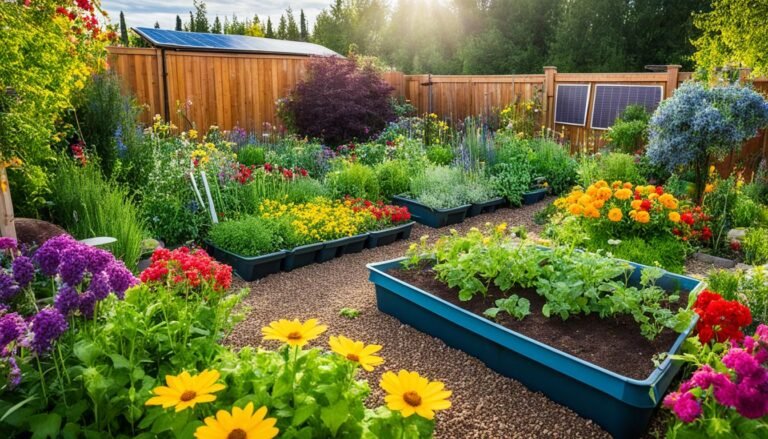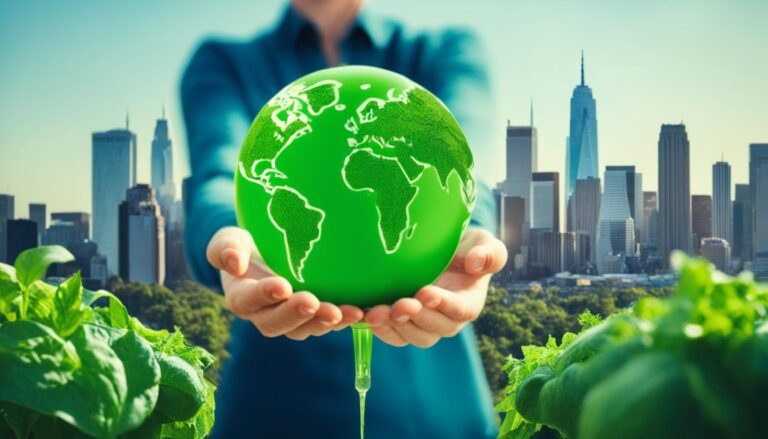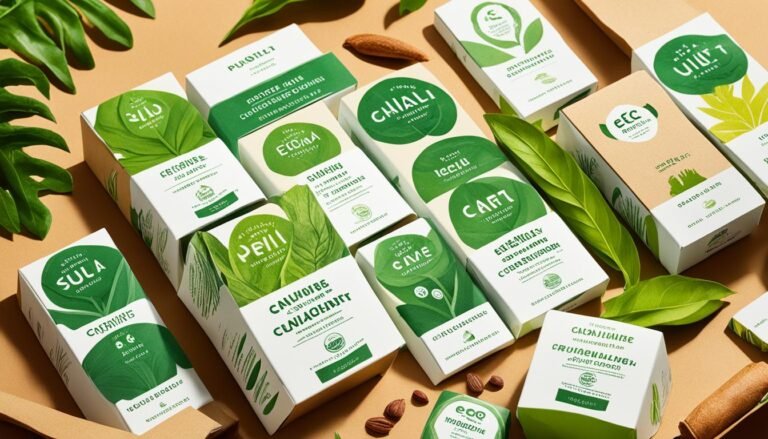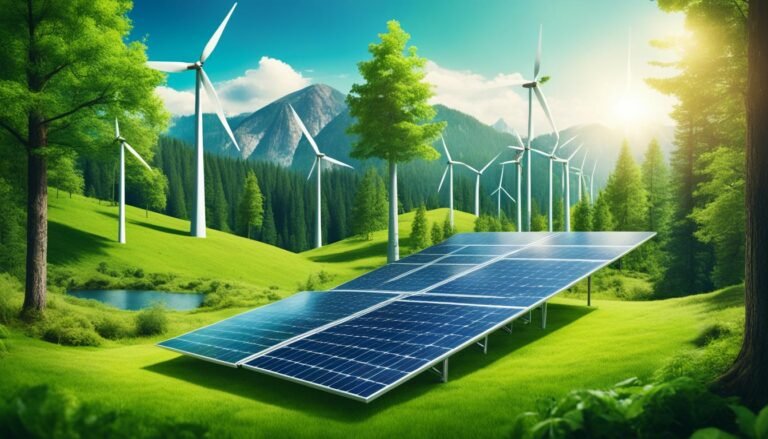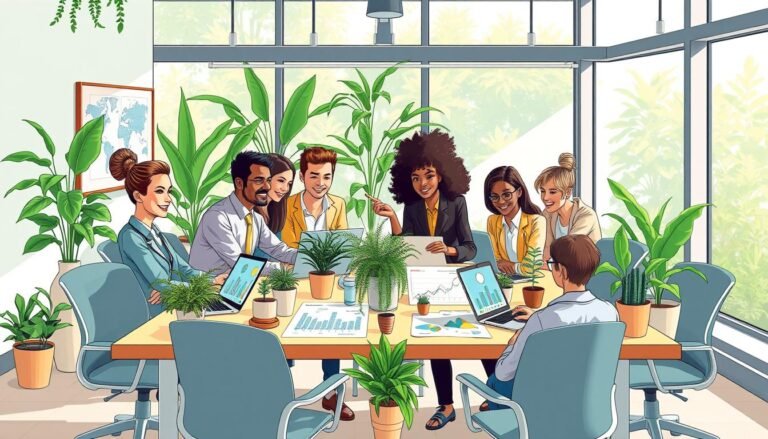The Circular Economy Explained: Closing the Loop on Waste and Resources
The circular economy is a new way of managing resources. It aims to reduce waste and use resources more efficiently. This is very different from the old way, where we used things up and threw them away. The goal is to solve big problems like climate change and pollution by using fewer resources.
This new economy is all about keeping things in use as long as we can. It focuses on using things again, fixing them, and recycling. By doing this, we can protect the environment, save resources, and manage waste better all over the world.
Key Takeaways
- The circular economy promotes sustainability by keeping materials in circulation.
- It aims to decouple economic growth from the consumption of finite resources.
- Core principles include eliminating waste and pollution, circulating products, and regenerating nature.
- A transition to renewable materials supports the circular economy’s goals.
- Addressing climate change, biodiversity loss, and pollution is central to the circular economy.
Introduction to the Circular Economy
The circular economy is a big change in how we use resources. It’s all about cutting down waste. And it means using what we have wisely. This way, we can keep making things without hurting the planet so much. This model is key for the Earth’s health in the future.
What is a Circular Economy?
The circular economy is all about smart use of materials. It wants to get rid of waste and keep things in use. Unlike the old way, which was to use and throw things away, the circular economy finds new uses. This not only helps the Earth but also leads to new and smart ways to do things in business.
Principles of a Circular Economy
Here’s how the circular economy works:
- Eliminating waste and pollution: It focuses on making things from the start to reduce waste and pollution all the way.
- Keeping products and materials in use: It pays attention to making things that last longer or are easy to fix. This way, we don’t need to use as many new materials.
- Regenerating natural systems: It supports making nature better. For example, using more renewable energy and materials that don’t harm the Earth.
Linear vs. Circular Economy
The big difference is how they use resources. The old way just takes and throws away. This can hurt our environment and use up all the resources. The circular economy is about a cycle. Things are made, used, and then turned into new things, so we need less new stuff. It’s better for the planet and helps us be more creative.
Choosing circular models is smart for both the Earth and our wallets. It means saving money and finding new ways to make and use things. By changing how we make and buy things, we can have a good life while taking care of our planet.
Core Principles of the Circular Economy
The circular economy wants to grow without using up too many resources. It tackles the big problem of waste with new ways to do things and thinking about the future. It’s about getting rid of waste and harmful stuff, using things more than once, and making the earth better. These ideas are key to making the world a better place for everyone.
Eliminate Waste and Pollution
In the circular economy, we try to get rid of waste and pollution. We change how things are made and used to be better for the earth. This means creating products that last longer and do less harm. This can really help our planet stay healthy.
This change also brings new chances for businesses and helps us protect the environment. New tech, like artificial intelligence, is making it easier to deal with waste and reduce pollution.
Circulate Products and Materials
The second idea is to use things for as long as we can. This means fixing, reusing, or recycling items. By doing this, we cut down on waste and save resources. For example, some companies are finding ways to make products without making as much new stuff, which cuts waste a lot.
Looking at cases where this has worked shows us the benefits. The car industry, for instance, has found that reusing parts can not only reduce waste but also save money and help the economy.
Regenerate Nature
The last principle is to fix instead of keep taking from the earth. Working with nature, like planting more trees, helps us produce food, energy, and make the environment better. This way, we give back to the earth too.
Learning more about these ways and spreading the word is very important. By focusing on helping nature heal, we ensure a strong and lasting future for the planet and us.
In short, following the circular economy principles is good for us and the planet. It means less waste and harm, and more good practices. By using new and old ways smartly, we can grow while taking care of the earth.
The Circular Economy Explained: Closing the Loop on Waste and Resources
The circular economy is a new way to make our world better. It moves us from harmful waste ways to reuse, recycling, and new ideas. For example, Apeel makes a coating that keeps fruits and veggies fresh longer. It stops the need for plastic wrap, which is good for our earth.
In this new economy, we make things that we can use again and again. Lush no longer uses shampoo bottles. Now, they have solid shampoos, cutting back on plastic waste. DyeCoo’s method of dyeing without water has saved a lot of water and kept chemicals out of our waterways.
Only a small part of our businesses work in this circular way, just 9%. But, there’s big hope for change. Napapijri makes a jacket using old fishing nets, making it easy to recycle. This jacket proves that making new from the old can work.
Big brands are using ECONYL®, a recycled material, in cars. Companies like Mercedes and Napapijri show us that reusing materials leads to less trash and cleaner air.
We don’t reuse almost all the stuff we make. This is a big problem. The UN says we throw away a lot of food. If we get better at using what we make and eat, we won’t hurt the earth as much.
Turning to a circular economy means more than just fixing trash. It’s about making everything in a way that helps our planet. Doing this will make the earth a better place for us all.
Benefits of a Circular Economy
A circular economy brings many advantages to the world. It changes how we view waste and resources. This model aims to create a future that is lasting and strong.
Environmental Benefits
Shifting to a circular economy lowers the pressure on our planet’s resources. The EU alone throws out more than 2.2 billion tonnes of waste each year. By reusing and recycling, this amount can drop significantly.
Moreover, these methods help cut down on greenhouse gas emissions. This happens because less industrial work is needed and waste is managed more efficiently.
Products that are easy to reuse or recycle stay in use longer. This cuts the amount of trash we make. It also means we don’t need to mine new materials as often, saving the Earth from more damage.
Economic Benefits
Going circular is a big economic opportunity. The EU spends a lot on raw materials imports, leading to a big trade deficit. Shifting to circular methods could create 700,000 new jobs in Europe by 2030.
This change not only boosts the job market but also creates a healthy green economy. It’s estimated to bring in up to $4.5 trillion in economic benefits by 2030.
It also pushes for new ways of doing business. Companies focus on making their products environmentally friendly. This spurs innovation, especially in sectors like construction and packaging.
Social Benefits
A circular economy helps everyone live better. It deals with resource shortages by using them smarter. This means resources are shared more fairly and waste is handled better. It supports jobs and growth in areas hit hard by a lack of resources.
By aiming for a full circular economy by 2050, the EU promises a better future. Strict recycling rules will be in place. This reduces harm to our environment and makes life better for everyone. Also, investing in green tech and infrastructure helps economies grow and supports communities.
Examples of Circular Economy in Action
The circular economy is changing how we think about being green. It comes up with new ways to cut waste and reuse things. Let’s look at some cool ways circular business models are working today.
Apeel: Extending Food Life
Apeel Sciences has a cool coating that makes food last longer. This means less food gets thrown away. They also help get rid of the plastic around our food.
Less waste, more food. And food gets to us more easily.
thredUP: Circular Fashion
thredUP is leading the way in circular fashion. It’s an online thrift store that lets people reuse clothes easily. This cuts down on making new clothes, which is good for our planet.
Mercedes Benz: Sustainable Car Interiors
Mercedes Benz is changing cars for the better. They use materials that are good for the earth in their interiors. This makes car-making less wasteful and shows others how to do it too.
Challenges in Implementing a Circular Economy
Moving to a circular economy comes with many challenges. The main aims are to be sustainable and efficient with resources. But, there are hurdles like old economic systems and needing newer technology and stronger institutions. Overcoming these obstacles is no simple task.
Economic Barriers
Most markets are set up for the old, linear way of doing things. This leads to just a tiny portion of resources being used again. This inefficiency holds back using greener methods. It’s also hard for companies, especially smaller ones, to make the change because it needs a big first investment. Also, prices for resources have gone up since the 2007-2009 crisis, adding to the challenge.
Technological Barriers
New tools are key to making circular ideas work, but there’s a gap here. Take textile making, for example. It’s starting to use newer methods like microbial fermentation. This helps reduce waste. But not everyone uses these methods yet because they’re not common. Even the dairy world is looking at ways to make milk proteins without cows, but this change is slow due to needing big investments.
Institutional Barriers
Good rules and leadership are needed to shift to a circular model. But most of the world’s people live where the environment is being damaged faster than it can recover. This puts a strain on working policies. The Ellen MacArthur Foundation suggests focusing on preventing waste. But doing this everywhere needs smart and fast policy action. That’s why we still see low numbers in plastic recycling.
Working together is key to overcome these obstacles. Companies should look at new business models for inspiration. Circle Economy’s Value Hill Business Model Tool shows four useful models. These efforts need strong support from institutions to work well.
Role of Businesses in the Circular Economy
Businesses are key players in the circular economy movement. They’re making their operations more sustainable and efficient. This change comes from using circular business models. These models cut down waste and use resources better.
“The Dutch city of Amsterdam has implemented a network of circular businesses working together to reduce waste and promote resource efficiency, positioning itself as the first circular city.”
Nike’s “Move to Zero” program sets high standards for environmental friendliness. It aims to lower the brand’s environmental impact and waste, including plastic. H&M’s “Closing the Loop” and Adidas’ Parley for the Oceans show great examples of these efforts. They’ve sold millions of shoes made from recycled materials.
- Siemens is focusing on sustainability with projects like the ESG project management initiative.
- Patagonia works on restoring the environment, reducing plastic waste, and selling used gear.
- HP is using plastics from the ocean in their products, showing their dedication to the cause.
Going circular is good for the pocket too. In the EU, saving on material costs for certain products could be up to $630 billion yearly. Global household items could save up to $700 billion. Plus, going circular could create new job opportunities.
Despite these benefits, only 9% of businesses are fully circular. Napapijri and major auto companies like Mercedes Benz are leading with eco-friendly choices. They use advanced materials like ECONYL® Regenerated Nylon.
For real change, businesses need to work together. They should create products that last longer and add value at every step. Following the UN’s advice for sustainable development can help in this transformation.
Role of Government and Policy in the Circular Economy
The government and its policies are key in sparking sustainability and eco-friendly action within the circular economy. They achieve this through making laws, offering financial benefits, and involving all parties. By doing so, they drive big changes in how we handle waste and resources.
Legislative Measures
All around the globe, governments are setting laws to lower harm to the planet and encourage green living. For example, they might ban items like single-use plastics or make recycling a must. These steps set clear rules to guide both businesses and everyday folks towards eco-friendlier choices.
Financial Incentives
Money matters when it comes to choosing sustainable options. Governments can help out by providing financial benefits like grants, tax cuts, and subsidies. This support boosts the use of circular economy strategies, making it easier for businesses to lessen their environmental impact.
Stakeholder Engagement
Working together with everyone involved is essential for making circular economy projects work. This includes companies, non-profits, and the public. Joining forces helps create a plan that tackles green issues together. It ensures that everyone’s ideas get heard.
Ongoing efforts aim to cut global material use by a quarter. But, there’s still a long way to go. We need to keep pushing for eco-friendly actions and circular economy principles. With just a small portion of our materials being reused now, we have a lot of room to get better. Government actions are crucial for propelling this positive change.
Designing for a Circular Economy
Designing for a circular economy means making products that can be used again and again. It leads to a greener way of living. Things are built to be easily fixed, made new, or reused.
Innovative Product Design
Coming up with new ways to make products is key to cutting waste. Choosing strong, recyclable materials helps things last longer. This way, we use up fewer resources.
Nowadays, we collect resources like crazy, more than ever before since 1970.
Disruptive Business Models
New business ideas are changing how we use stuff. They focus on sharing and the job things do, not just owning them. This helps use up less new stuff, which we use less than 10% again globally.
Creating Multi-use Products
Making things that can be used in many ways is key. They help us cut back on waste and the need for new materials. With less than 20% of used materials getting reused, this really matters.
Circular Economy in Different Sectors
The ideas of a circular economy touch many sectors. This includes everything from fashion to food and cars. As people learn more about the environment, they watch companies closer. This can change how much trust and loyalty people have in a brand. Now, let’s see how three big areas are using these ideas to do better for the planet.
Fashion Industry
The fashion world is known for making a lot of waste and hurting the earth. But, sustainable fashion is changing that. It uses things like organic materials and fixes old clothes to sell again. Big names such as Stella McCartney are leading this change. They make sure clothes are made ethically and can be used again. This helps fight problems like climate change and animals losing their homes.
Food Industry
Making and selling food often leads to a lot of waste. But some companies are trying hard not to waste food. Zero-waste food means finding new uses for food that would otherwise be thrown away. OLIO and Imperfect Foods are good examples. They share extra food and use cool new ways to package and sell it. This helps business stay strong and keeps the earth healthy.
Automotive Industry
Car makers are also taking big steps to be kind to the earth. Sustainable automotive practices focus on using old items in new cars. Companies like Tesla and BMW are leaders in this. They use more recycled stuff and green ways to build cars. Mercedes-Benz is also working hard. They use eco-friendly materials inside cars to help them last longer. These efforts help reduce pollution and save materials.
Accenture says we must find new ways to grow without using up all our resources. They say if we don’t change, the world could face a loss of $4.5 trillion by 2030. But, thanks to new technology, using the circular economy is getting cheaper. This news is good for many sectors who are trying to do better for the earth.
Future of the Circular Economy
The future of the circular economy is bright. It’s powered by a global push for sustainability and reducing waste. Both companies and governments see the urgent need for better waste management. This is leading to more investments in recycling and new technologies. These changes help move us from a straight line to a circular economy. They play a big part in reaching our sustainability goals.
Global Trends
The circular economy is catching the eye of people worldwide. Big names like Walmart, Unilever, P&G, PepsiCo, and The Coca-Cola Company, among others, are investing early. They show a real commitment to being greener. Others, like 3M, Amazon, and BlueTriton, are joining in, too. Thanks to their efforts, a huge amount of materials are being reused. This reduces waste and harmful emissions.
Technological Advancements
Technology is key in pushing the circular economy ahead. PureCycle Technologies is creating smart ways to recycle plastic. These methods turn plastic waste into new, high-quality material. This is a big step in making recycling more effective. Also, Redwood Materials is focusing on recycling parts of old batteries. This shows we can get better at reusing what we’ve thrown away.
Sustainable Development Goals
The circular economy supports the UN’s Sustainability Goals. It’s all about using resources carefully and making things in a better way. The Center for the Circular Economy is working on making supplies and manufacturing greener. Companies like Circular Services are investing a lot in new recycling efforts. They show that the private sector can really make a difference. With their help, we’re aiming for a more sustainable future.
The Closed Loop Partners have created more than 1,000 jobs. They’ve also kept millions of tons of materials in use. This has a big effect on waste and emissions, cutting down on both. The circular economy keeps getting better, showing it’s key in fighting climate change. It also makes businesses work smarter. All in all, the future of the circular economy looks promising. It promises a greener, more successful global market.
Conclusion
The circular economy is changing the game with how we manage resources. It offers a new, smarter way that keeps our planet in mind. By shifting to circular systems, we could make a huge impact. For example, we could cut carbon dioxide emissions in half by 2030. We could also lower the use of artificial fertilizers by 80%. This info comes from the Ellen MacArthur Foundation.
This shift isn’t just good for the environment. It’s also a win for the economy. A circular economy can create many jobs. In the UK, it might create 50,000 new positions. In the Netherlands, it could be as many as 54,000. Plus, using materials more efficiently could lead to big savings. These savings help the economy grow stronger.
This change to a circular economy needs everyone on board. Businesses, governments, and people all play key roles. If we all work together, we can improve our soil. We can also tackle climate change, loss of biodiversity, and waste. By joining forces, we can turn the circular economy dream into reality. This way, we can aim for zero waste. This will secure a better future for everyone.
Source Links
- Circular economy introduction
- Closing the loop on the circular economy
- The Circular Economy Explained
- Circular Economy Month Week 1: Introduction to Circular Economy
- Circular Economy – Beginner’s Guide
- The Circular Economy in Automotive: Closing the Sustainability Loop
- The Circular Economy as a Solution for Global Waste Issues
- The circular economy in detail
- A Comprehensive Overview of Circular Economy: Promoting Sustainable Resource Management
- Eliminate waste and pollution
- Circular Economy Explained: What does it mean and how do we close the loop? – Econyl
- What is Circular Economy & How Does It Work? : Complete Guide – RTS
- Circular economy: definition, importance and benefits | Topics | European Parliament
- Circular Economy: The Benefits and Strategies for Implementing Sustainable Practices
- Pursuit of A Circular Economy & Benefits Of A Closed-Loop
- 10 Examples of Circular Economy Solutions
- Best 7 Circular Economy Examples
- What is the circular economy? | Golisano Institute for Sustainability
- Closing the loop: Embracing the circular economy
- Circular Economy Challenges & Opportunities
- Sustainability Blogs
- Beyond Recycling: Policy to Achieve Circular Waste Management
- Designing for Circular Economy: Waste Reduction, Recycling, FRP
- Closing the loop: Responsible investment and the circular economy
- ESG Thema #4 – Investing in the Circular Economy: Closing the loop
- Advancing the Circular Economy
- 10 Years of Building the Circular Economy – Closed Loop Partners
- Circular Economy – Definition, Principles, Benefits and Barriers
- Closing loop of circular economy for Corporate Sustainability & Responsibility



